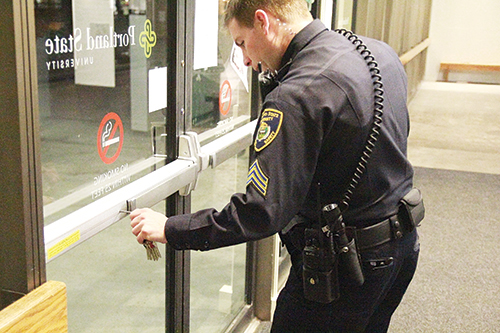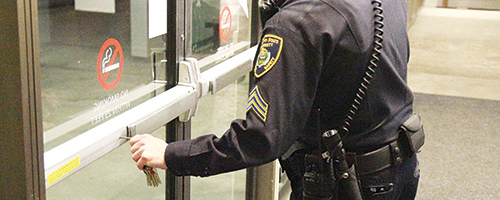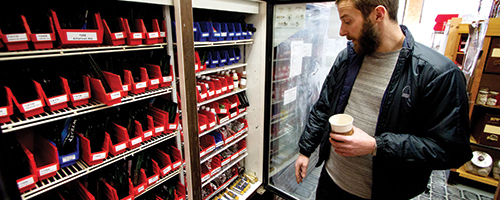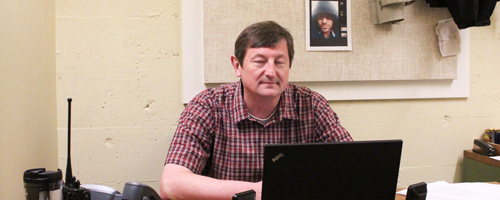From Dec. 22 to New Year’s Day, almost every Portland State building was locked and closed—save residence halls, where some students spent their winter breaks.
Campus locks down for break
 Sgt. Michael Anderson locks an entrance to Science Building One during standard patrol. The Campus Public Safety Office plans to implement full campus closures for future breaks. Photo courtesy of Drew Martig.
Sgt. Michael Anderson locks an entrance to Science Building One during standard patrol. The Campus Public Safety Office plans to implement full campus closures for future breaks. Photo courtesy of Drew Martig.
From Dec. 22 to New Year’s Day, almost every Portland State building was locked and closed—save residence halls, where some students spent their winter breaks.
The closure was coordinated by university administration and the Campus Public Safety Office in an effort to save energy and improve campus security during the winter holiday.
“It represents smart stewardship,” CPSO Chief Phillip Zerzan said.
With access to campus facilities limited, CPSO saw a decrease in burglaries, theft, vandalism and other criminal activity that usually occurs during normal academic terms. In addition, overall power usage decreased significantly.
“The results were fantastic,” said Steve Coop, a public safety officer who was involved in organizing the closure.
In the past, the university has employed similar plans, but Zerzan said this year was more thorough and universal in its approach.
“I would say that we were a little more diligent and thoughtful in locking buildings, limiting access and turning down heating,” he said.
The comprehensive closure was in the works for quite some time, with initial planning beginning almost six months ago.
Even though classes were not in session, faculty still needed access to necessary university research facilities.
“There are not that many people on campus, so there is a significant cost saving to closing buildings and only having necessary personnel,” said Scott Gallagher, director of PSU’s Office of University Communications.
“It makes us more sustainable, and we save money at a time when the campus is empty anyway,” he added.
To determine who could access university buildings during the closure, academic department heads selected faculty members who were essential to ongoing research.
The vice president of Finance and Administration approved the final list of individuals, who were then given special access to facilities.
“Our focus in closure is ensuring that the academic needs and research needs of the university [are met], as well as the safety and security needs of the people,” Coop said.
The closure also allowed for repairs and maintenance that required an empty campus to be done properly.
The maintenance was primarily electrical, and called for checking electrical conduits, turning power off and on and identifying areas that need upgrading and improvement.
“You can’t do that [maintenance] when classes are in session and researchers are in labs,” Gallagher said.
CPSO and the administration intend to implement this level of campus closure for future breaks during the academic year, as well as in extreme weather conditions.
“The closure goes beyond the winter,” Coop said.
“There are not that many people on campus, so there is a significant cost saving to closing buildings and only having necessary personnel,” said Scott Gallagher, director of PSU’s Office of University Communications.
“It makes us more sustainable, and we save money at a time when the campus is empty anyway,” he added.
To determine who could access university buildings during the closure, academic department heads selected faculty members who were essential to ongoing research.
The vice president of Finance and Administration approved the final list of individuals, who were then given special access to facilities.
“Our focus in closure is ensuring that the academic needs and research needs of the university [are met], as well as the safety and security needs of the people,” Coop said.
The closure also allowed for repairs and maintenance that required an empty campus to be done properly.
The maintenance was primarily electrical, and called for checking electrical conduits, turning power off and on and identifying areas that need upgrading and improvement.
“You can’t do that [maintenance] when classes are in session and researchers are in labs,” Gallagher said.
CPSO and the administration intend to implement this level of campus closure for future breaks during the academic year, as well as in extreme weather conditions.
“The closure goes beyond the winter,” Coop said.





